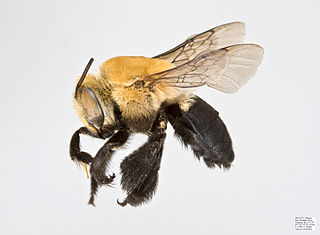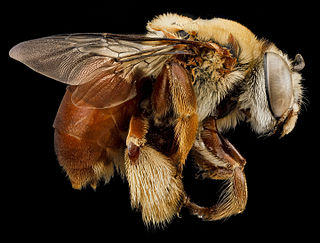
The genus Centris contains circa 250 species of large apid bees occurring in the Neotropical and Nearctic realms, from Kansas to Argentina. Most females of these bees possess adaptations for carrying floral oils rather than pollen or nectar. They visit mainly plants of the family Malpighiaceae to collect oil, but also Plantaginaceae, Calceolariaceae, Krameriaceae and others. Recent studies have shown they are sister to the corbiculate bees, the most well-known and economically important group of bees
Centris cockerelli is a species in the family Apidae, in the order Hymenoptera . The distribution range of Centris cockerelli includes Central America and North America.
Centris atripes is a species of centridine bee in the family Apidae. It is found in Central America and North America.

Centris errans, known generally as wandering centris, is a species of centridine bee in the family Apidae. Other common names include the Florida locust-berry oil-collecting bee and spiny bear's-breech. It is found in the Caribbean and North America. The species is one of five from the family Apidae that are endemic to the state of Florida. The species occurs the southernmost portion of Florida.

Centris nitida is a species of centridine bee in the family Apidae. It is found in Central America.
Ericrocis lata is a species of centris-cuckoo bee in the family Apidae. It is found in Central America and North America.

Ericrocis is a genus of centris-cuckoo bees in the family Apidae. There are at least four described species in Ericrocis.
Centris rhodopus, the red-legged centris, is a species of centridine bee in the family Apidae. It is found in Central America and North America.

Centris lanosa is a species of centridine bee in the family Apidae. It is found in North America.
Centris caesalpiniae is a species of centridine bee in the family Apidae. It is found in Central America and North America.

Ericrocis pintada is a species of centris-cuckoo bee in the family Apidae. It is found in Central America and North America.

Agapostemon splendens, the brown-winged striped-sweat bee, is a species of sweat bee in the family Halictidae.

Anthophora urbana is a species of anthophorine bee in the family Apidae. It is found in Central America and North America.

The golden alexanders miner bee is a species of miner bee in the family Andrenidae. Another common name for this species is the golden-alexanders andrena. It is found in North America.

The aster miner bee is a species of miner bee in the family Andrenidae. It is found in North America.
The brown-tailed miner bee is a species of miner bee in the family Andrenidae. Another common name for this species the dark-tailed andrena. It is found in North America.

The eastern willow miner bee is a species of miner bee in the family Andrenidae. It is found in North America.
The shiny green miner bee is a species of miner bee in the family Andrenidae. Another common name for this species is the white-winged perdita. It is found in Central America and North America.

Svastra obliqua, the sunflower bee, is a species of long-horned bee in the family Apidae. It is found in Central America and North America.

The Bradley's miner bee is a species of miner bee in the family Andrenidae. Another common name for this species is Bradley's andrena. It is found in North America.










